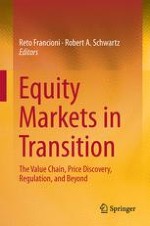2017 | OriginalPaper | Chapter
10. Security Market Microstructure: The Analysis of a Non-frictionless Market
Authors : Reto Francioni, Sonali Hazarika, Martin Reck, Robert A. Schwartz
Published in: Equity Markets in Transition
Publisher: Springer International Publishing
Activate our intelligent search to find suitable subject content or patents.
Select sections of text to find matching patents with Artificial Intelligence. powered by
Select sections of text to find additional relevant content using AI-assisted search. powered by
